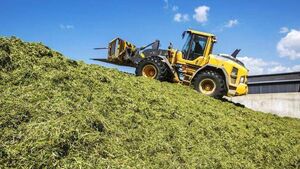Council warns Kildare farmers about silage rules

Photo for illustrative purposes only
KILDARE County Council wants to remind farmers of their obligations regarding the management and storage of silage and silage effluent, in order to protect the environment and ensure water quality is not impacted.
Ahead of this year’s silage season, farmers are required to ensure that silage storage facilities are fit for purpose. The silage pit and silage effluent collection and storage facilities must meet the standards required by the Department of Agriculture, Food and the Marine (DAFM).
Silage pits, slabs and walls, need to be structurally sound to ensure ensiling (the manufacture of silage) is completed within a leak proof structure.
Silage effluent is a particularly potent pollutant, with 200 times more polluting potential than raw domestic sewage, and can cause serious pollution of waters, or contaminate drinking water supplies, if not collected, stored and applied properly to land.
Now, while silage pits are empty, it is a good opportunity to safely examine the silage pit slabs, walls and channels to determine what maintenance and repairs are needed before the silage pit is used again in 2025.
Whilst carrying out your maintenance checks, farmers are advised to wash down the silage pit floor, effluent channels and surrounding walls with a power washer.
Check for cracks, porous patches, unsealed and eroded joints, because the silage pit, channels and collection tanks must be leak-proof and be capable of safely storing the volume of all effluent generated.
If the pit is not fit for purpose, cease using until all repairs are completed, and these repair works must be completed to the specifications for Concrete Silage Bases S128 and Resurfacing of Silo Floors S128A.
Regular maintenance of the silage pit ensures that minor problems can be rectified before they escalate to more serious issues.
When cutting silage, wilt the grass for 24 hours before ensiling. to reduce the volume of silage effluent produced.
All effluent should enter the channels under the cover of the silage polythene and the edge of the ensiled grass should not extend onto, or over, any channel. The open space is maintained by placing a plastic drainage pipe in the channel.
Problems with silage effluent management can arise when silage is made in a larger quantity than the slab is designed to hold.
Additional silage should be stored on another slab or made into round bales, and all silage should be stored on a concrete base, and do not store pit silage on a hardcore base, even if it is very dry silage and was made during ideal conditions.
During the ensiling period, make sure that all effluent is diverted into the underground slurry tank or effluent tank. Make sure that these channels are free of any debris and that the effluent can flow unrestricted.
Where a suitable wilt is not possible due to wet weather, it is advisable to provide additional drainage pipes to help ensure that the liquid gets away.
These could be laid at the butt of clamp walls or, for long clamps, additional pipes could be laid across the pit. These will help relieve the pressure build up from the effluent and reduce the possibility of the pit slipping.
To prevent effluent from flowing out over silage walls in the first few days, it is important not to pile the grass too high over the walls and to slope the grass back at a 45Ë angle from the top of the walls. All effluent should be collected and channelled into an underground slurry or effluent tank.
When land spreading silage effluent, dilute the effluent with one part water/slurry to one part effluent.
Do not apply silage if land is waterlogged or frozen, within 48 hours of heavy rain, or if rainfall is forecasted within the next 24 hours.
Do not spread within 5m of any surface waters (10m where the slope of the land exceeds 10%), 20m from a main river or lake, or 25 - 200m of a well/public water supply.
Silage bales, including dry matter silage or haylage, can only be stored a maximum of two bales high, in the absence of adequate facilities for the collection and storage of any effluent that may arise, and all silage bales should be stored at least 20m from surface water or a drinking water abstraction point.





